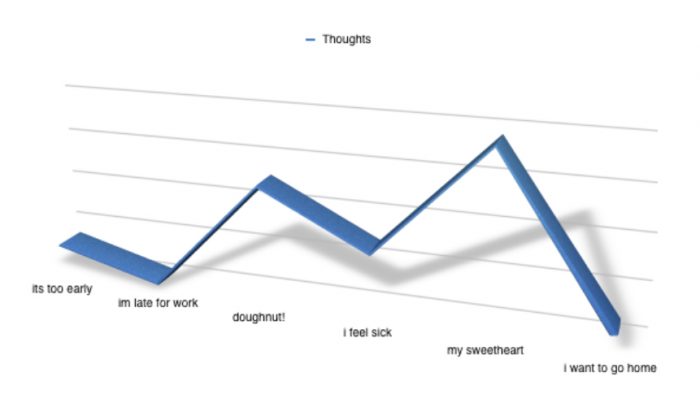

This diagram represents your thoughts and feelings during the course of an average day. Your thoughts are represented along the x axis and your feelings along the y. When you have a thought that brings a good feeling, your mood improves, when you have a thought that brings a bad feeling, your mood declines.
You already knew this? Are you sure? Because most people behave as though things in the external world shapes their thoughts and feelings, and this is one of the greatest and innocent misunderstandings of all time, because it looks to be so real and true.
As you can see from the diagram, when we follow thoughts and feelings our moment-to-moment experience can fluctuate madly as we analyse, solve, make meaning, act upon, or devise plans to counter or validate these thoughts. But when our thoughts are mapped out objectively in a graph, we can see that most thoughts are fairly arbitrary, the ‘doughnut thought’ could bring us to our knees or float past barely detected. The doughnut is real and it is there, but has no inherent meaning, until we create a monster from it with layers and layers of thinking around an entirely benign sugar-coated circular edible object with a hole in the middle.
But notice something, take another look at the ‘doughnut thought’. For those among you who love doughnut, this diagram would correctly represent your feeling as it improves at the point of ‘doughnut thought’. For those who are on a strict diet, the donut might represent guilt, shame or temptation which would mean you would feel worse. This is how the system is designed to work, and it works beautifully, as a compass to direct and understand our experience on an individual basis, we all experience things differently.
Thought is not reality: yet it is through thought that our realities are created” Sydney Banks
When you think about anything, you are not seeing an object/person/scenario as it is, you are seeing your thought-constructed version of it. This system works wonderfully and is precisely why I can be a daughter, colleague, lover, nightmare, saviour, or anonymous, all at the same time to different people. To other people ‘Suzanne’ is simply a construction of their personal thought and feeling. As others are to you.
“Someone once said to me, ‘Are you telling me that chair isn’t real, that it’s only thought?’ I said ‘Of course the chair is real. But it comes to you via Thought” Sydney Banks
But here comes the game changer. Let’s go back to the doughnut. Your thoughts aren’t actually telling you anything about the doughnut, there is no need to act on them and most importantly, judge, or analyse them.
From a neuroscience perspective, the lower brain is designed to automate our behaviour by making action almost unconscious after enough repetition, like driving for example, after a few years behind the wheel, it becomes automatic. In the same way, if you have a thought that creates an uncomfortable feeling and is repetitive and causes you discomfort, the chances are you have been practising it by thinking, analysing and worrying. The reason it seems as though it’s being played on repeat without your permission is because – it is.
This is not to say you should try to change these thoughts, that’s adding more thinking on to thinking which empowers it. Just realising, simply seeing that it is not giving you a message, it’s not a signal to act, it’s not a reflection of your life, or of you as a person, is all you need to see. Eventually, these thoughts go from boiling, to simmering, to still. Just turn the gas off the stove. That’s all you need to do.
Our thoughts are actually only tied to our experience when we believe them to be a true representation of reality, and something we either need to act upon, analyse or correct. This is actually good news, and something that we are all somewhat already aware of, as many of us would be very lonely if we acted on the ‘I’m going to kill you’ thought, when our precious friends and family do something that isn’t to our liking. Or, if we treated the thought as though it was serious, and considered a course of psychotherapy to change these thoughts so as not to be of serious risk to our fellow human beings.
When our personal thought is not utilised to navigate our life, we create space for something else. When we loosen our grip on thoughts that create a myriad of confusion and a rollercoaster of emotions, we are calm, quiet, and peaceful.
When we are quiet, calm and peaceful, we embody our essential nature, and feelings of love, creativity, compassion and happiness arise, from which insight and wisdom occur. We have all experienced the wisdom of our deeper voice from time-to-time, and not one of us does not recognise it when it speaks.
In practical terms, if it is repetitive, and causes fear or anxiety or a low mood, it’s our personal thinking. If it arises from a positive, calm state and seems obvious and natural, it’s wisdom. That’s not to say that our wisdom will always guide us to meditate, or wonder through a forest barefoot, sometimes it asks us for acts of courage and change, but its message will fill us with wonder and possibility and strength, because we will know it as truth.
https://www.thethreeprinciples.org.uk/
Browse Front PageShare Your IdeaComments
Read Elephant’s Best Articles of the Week here.
Readers voted with your hearts, comments, views, and shares:
Click here to see which Writers & Issues Won.








